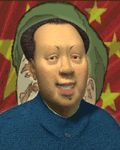The Chinese |
|||||||||||||||||||||||
| Profile | |||||||||||||||||||||||
|
|||||||||||||||||||||||
|
Chinese Cities
Great Leaders
|
Background
Despite political and social upheavals that frequently ravaged the country, China is unique for its longevity and resilience as a politico-cultural entity. Most of China’s cultural progress has been accomplished with relatively little outside influence; even when the country was ruled by such “barbarian” peoples as the Chin or Mongols, these were soon absorbed into the fabric of Chinese culture. The casting of bronze and the development of an alphabet date from the period of the Shang dynasty, China’s first, believed to have dominated north China from the mid-16th to mid-11th century BC. The overthrow of the Shang dynasty by the Chou (1111-255 BC) spanned three generations; although the vibrant Chou culture produced some of history’s greatest philosophers and artists, among them Confucius and Lao-zi, it was eventually supplanted by a “barbarian” invasion that established the brief Ch’in Empire (221-206 BC). The subsequent Han dynasty was founded by Liu Pang, who assumed the title of emperor in 202 BC. The four centuries of the Han was one of considerable changes in imperial, political, cultural and social development, as well as massive engineering projects (including the Great Wall), and established a Chinese identity that would survive until the advent of Communism. By the end of the 2nd century AD the Han Empire had virtually ceased to exist, followed by a lengthy period of rival kingdoms that did not end until 618 AD, when the T’ang dynasty came to power. The T’ang were followed by the Sung dynasties (960-1279 AD), which collapsed in the face of the Mongol invasions. By securing the allegiance of the Hsi Hsia in Tibet (1209), Genghis Khan disposed of a potential enemy and prepared the ground for an invasion of China. For several years Mongol armies pillaged the country; finally, in 1214 Genghis overwhelmed the capital of the northern Chin (modern Peking). During the next decades there was an uneasy truce between the Mongols in the north and the Sung state in the south. The Mongols resumed their advance in 1250 under Kublai Khan, grandson of Genghis. From 1267 onward, the Mongols, this time assisted by the armored horsemen Riders and auxiliary troops of north China, attacked on several fronts. When organized resistance ceased soon afterward, foreign invaders controlled the whole of China for the only time in history. The Mongols occupied China for a century, but ineptitude on the throne, factionalism at court, and rivalries among generals weakened their rule. Out of this turmoil emerged a new native dynasty, the Ming (1368-1644), known for patronage of the arts. The Ming were followed by the Manchus (1644-1911), the last imperial dynasty of China, marked by continuous warfare, Western imperialism, rampant corruption and bureaucratic ineptitude. In the wake of the disastrous Boxer Rebellion, the imperial court could no longer maintain support among the peasantry and army; revolution (1911-1912) followed. The first half of the 20th century saw the disintegration of the old order in China and the foundations of a new society, begun by the short-lived democratic Republic (1912-1920), which quickly degenerated into the dictatorship of Yuan Shih-k’ai. A new revolution, led by the Nationalist Party (KMT) and the Chinese Communist Party (CCP), erupted. Although united against the Japanese invasion, by the end of World War II civil war raged in China. Nationalists and Communists raced to take over Japanese-held territories, built up their forces, and fought limited engagements while still conducting negotiations; during 1947-1948, after initial Nationalist victories, the strategic balance shifted in favor of the Communists. Four years after Japan’s surrender, a profound and popularly based revolution had swept China, and, in October 1949 Mao Tse-tung proclaimed the People’s Republic of China. In 1966, the Communists launched the disastrous “Cultural Revolution,” a ten-year assault on “traditional values” and “bourgeois thinking” which ultimately left the country in disarray. After Mao’s death in 1976, his rival Deng Xiaopeng assumed power and began social and economic reforms that would see China return to world prominence. Unique Unit: the Rider The Rider is an upgraded version of the Knight. Like the knight, it requires both iron and horses to build, but it has bonus to its movement ratings, which makes it an extremely valuable siege unit. Its upgraded movement rate makes quick strikes possible and allows the Chinese to keep a smaller standing defense, since units can quickly move to bolster positions of weakness.
|
||||||||||||||||||||||

 The Chinese are militaristic and industrious. They start the game with Warrior Code and Masonry and build riders instead of normal knights.
The Chinese are militaristic and industrious. They start the game with Warrior Code and Masonry and build riders instead of normal knights.  China leads the world in terms of horse population, having nearly 11 million horses within its borders. Once the discovery of the stirrup made its way to China, heavy cavalry soon followed. As the Chinese found out first-hand when the Mongols invaded in the 12th century, it is better to have heavy calvary than to be attacked by them.
China leads the world in terms of horse population, having nearly 11 million horses within its borders. Once the discovery of the stirrup made its way to China, heavy cavalry soon followed. As the Chinese found out first-hand when the Mongols invaded in the 12th century, it is better to have heavy calvary than to be attacked by them.